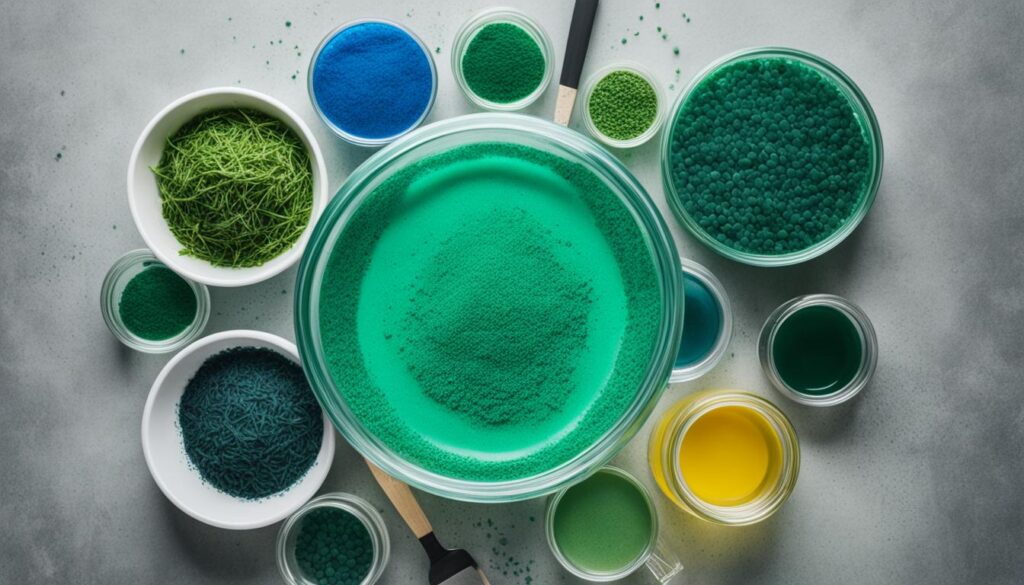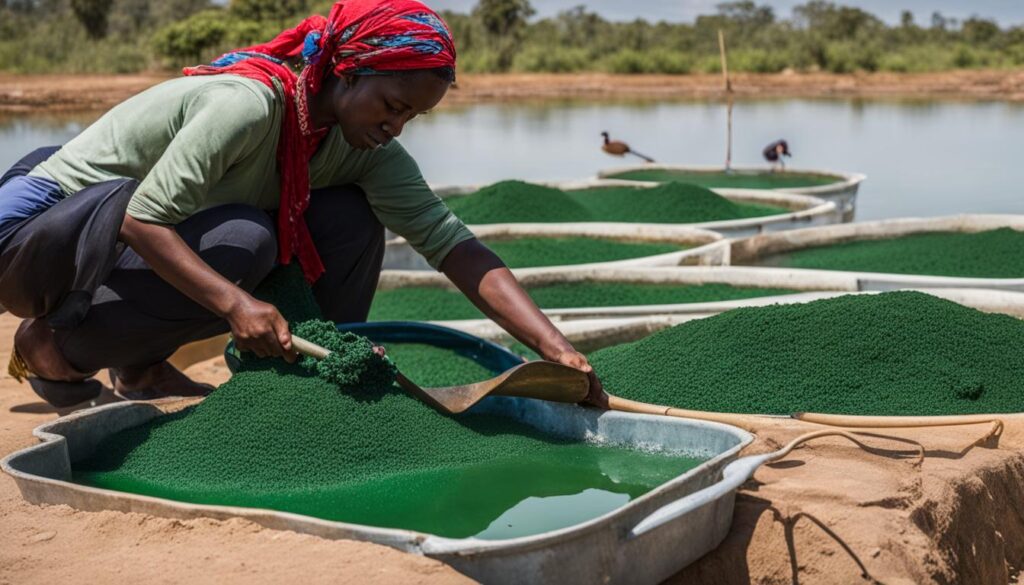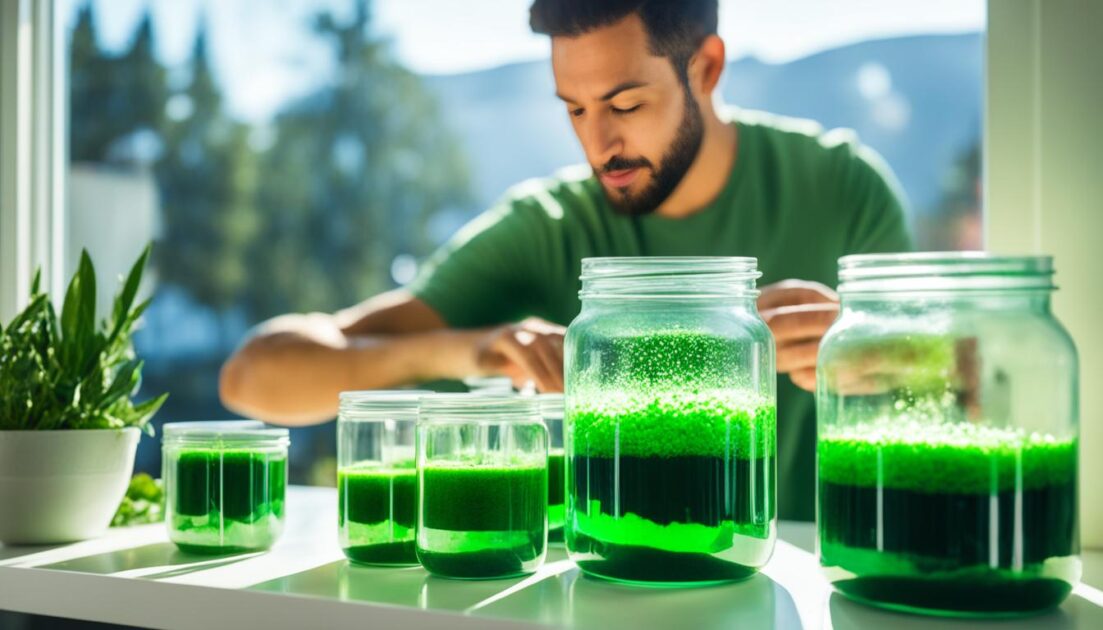Spirulina, a blue-green algae that has been consumed as a food source for centuries, is gaining popularity due to its abundant nutrients and health benefits. If you’re interested in cultivating spirulina at home, this easy guide will walk you through the process step by step.
To start cultivating spirulina, you’ll need a few key elements. These include a transparent container, distilled water with a pH level between 8 and 10, sufficient sunlight with shade, and a live spirulina culture. By providing the right environment and nutrients, you can grow your own spirulina right in your home.
Key Takeaways:
- Grow your own spirulina at home using a transparent container, distilled water, sunlight, and a live spirulina culture.
- Maintain optimal conditions for spirulina growth by monitoring water temperature, pH levels, and providing shade when needed.
- Start the culture using quick sowing or rapid sowing methods, ensuring good agitation and shade during the growth phase.
- Harvest spirulina when the water pH stays at 10 for 24 hours and store it properly for future use.
- Simplify spirulina cultivation with the AlgenAir spirulina cultivation kit, which includes all the necessary tools and ingredients for easy home farming.
Creating the Optimal Growing Environment
Spirulina is a highly adaptable algae that requires certain conditions to thrive and grow successfully. To maintain optimal conditions for spirulina growth, it is essential to consider factors such as temperature, sunlight, water pH level, and agitation.
Suitable Temperature Range
Spirulina grows best in warm temperatures between 55 and 100 degrees Fahrenheit (13 to 38 degrees Celsius). This temperature range provides the right balance for its metabolic activities and promotes healthy growth. Extreme temperatures outside this range can hinder the algae’s growth and overall health.
Sunlight – A Vital Source of Energy
Spirulina requires a fair amount of sunlight to carry out photosynthesis, a process through which it synthesizes nutrients and grows. However, direct and intense sunlight can be detrimental to spirulina’s growth. Therefore, it is crucial to strike a balance by providing sufficient sunlight while also ensuring shade to protect the culture from excessive heat and light exposure.
Monitoring Water Temperature and pH Level
Regular monitoring of the water temperature and pH level is crucial for maintaining optimal conditions for spirulina cultivation. The ideal pH range for spirulina growth is between 8 and 10. Fluctuations in pH levels can inhibit growth and affect the overall health of the culture. Similarly, it is important to keep the water temperature within the suitable range mentioned earlier, as excessive heat or cold can negatively impact spirulina growth.
Agitation and Shade
Adequate agitation in the culture tank helps promote proper distribution of nutrients and oxygen throughout the water. This can be achieved by stirring the water regularly, as it prevents stagnation and maximizes spirulina growth. Additionally, providing shade when necessary helps protect the culture from excessive sunlight, maintaining an optimal growing environment.
By maintaining these optimal conditions, spirulina growers can ensure its health and maximize its growth potential. The next section focuses on the seeding and cultivation techniques for spirulina, enabling you to kickstart your spirulina cultivation journey!
Comparison of Optimal Conditions for Spirulina Growth
| Factors | Optimal Conditions |
|---|---|
| Temperature | Between 55 and 100 degrees Fahrenheit (13 to 38 degrees Celsius) |
| Sunlight | Moderate sunlight with shade to prevent excessive heat and light exposure |
| Water pH Level | Between 8 and 10 |
| Agitation | Regular stirring and distribution of nutrients |
| Shade | Providing shade when needed to protect from excessive sunlight |
Now that you understand the importance of maintaining optimal conditions, let’s move on to the next section, where we will explore the seeding and cultivation techniques for spirulina.

Seeding and Cultivating Spirulina
When it comes to cultivating spirulina, there are two effective seeding techniques: quick sowing with freshly pressed spirulina and rapid sowing with concentrated spirulina. Each method has its own advantages and considerations, allowing you to choose the approach that best suits your needs.
Quick Sowing:
Quick sowing involves introducing a large quantity of freshly pressed spirulina into the water tank. This method is ideal for kickstarting the growth process and establishing a thriving spirulina culture. The fresh spirulina provides an abundant food source for the algae, allowing them to multiply and flourish.
Rapid Sowing:
Rapid sowing, on the other hand, utilizes concentrated spirulina to quickly populate the water tank. This technique is convenient if you have a limited supply of freshly pressed spirulina or want to speed up the seeding process. By transferring concentrated spirulina to the tank, you can jumpstart the growth phase and ensure a robust spirulina colony in no time.
During the growth phase, it is essential to maintain good agitation in the water tank. Proper agitation promotes nutrient distribution and prevents stagnation, facilitating healthy spirulina growth. Additionally, providing shade to the pool helps protect the spirulina from excessive sunlight, maintaining optimal conditions for growth.

| Seeding Method | Advantages | Considerations |
|---|---|---|
| Quick Sowing | Accelerated growth | Requires a large quantity of freshly pressed spirulina |
| Rapid Sowing | Efficient and time-saving | Relies on concentrated spirulina supply |
By following these seeding techniques and ensuring proper agitation and shading, you can cultivate a thriving spirulina culture. The next section will explore the crucial steps for harvesting and maintaining spirulina, allowing you to enjoy the benefits of homegrown spirulina.
Harvesting and Maintaining Spirulina
Once your spirulina has reached the optimum pH level of 10 for 24 hours, it’s time to harvest your nutritious algae. Harvesting spirulina is a relatively simple process that ensures you can enjoy its benefits to the fullest. Let’s take a look at the spirulina harvesting methods and maintenance tips to keep your spirulina thriving.
Spirulina Harvesting Methods
- Scooping: Using a clean spoon or cup, gently scoop out the spirulina from the water tank. Be careful not to disturb the water too much to avoid contamination.
- Straining: After harvesting, it’s essential to remove excess water from the collected spirulina. Rinse the harvested algae through a fine strainer cloth to ensure the removal of any remaining water.
Now that your harvested spirulina is free from excess water, it can be used fresh in a variety of recipes or stored for later use. To maintain its freshness, store the spirulina in an airtight container in the refrigerator for a few days.
Spirulina Maintenance Tips
To ensure the longevity and health of your spirulina colony, proper maintenance is crucial. Here are some maintenance tips to follow:
- Replenishing nutrients: After each harvest, it’s important to replenish the food source for your spirulina. Add fertilizer in equal amounts to the harvested spirulina to provide the necessary nutrients for its growth and multiplication.
- Monitoring water quality: Regularly monitor the water temperature and pH levels to maintain optimal conditions for spirulina growth. Adjust as necessary to ensure a conducive environment.
- Managing sunlight exposure: While spirulina requires sunlight for photosynthesis, excessive direct sunlight can be harmful to its growth. Provide shade when needed and monitor the exposure level to maintain a healthy balance.
- Regular maintenance: Perform routine checks on the water tank, cleaning any debris or algae buildup to prevent contamination. Stagnant water can hinder spirulina growth, so ensure good agitation to keep the water oxygenated.
By following these spirulina maintenance tips, you can enjoy a thriving and abundant supply of this nutrient-rich superfood.

Simplifying Spirulina Cultivation with AlgenAir
If you’re interested in growing spirulina at home but find the process daunting, AlgenAir has the perfect solution for you. Their AlgenAir Spirulina Cultivation Kit is designed to make home spirulina farming easy and accessible for everyone.
With this innovative kit, you’ll receive everything you need to start your own home spirulina farm. The algae-based purifier set includes a water container, spirulina culture, and nutrient formulation, ensuring that you have all the necessary tools and ingredients at your fingertips.
One of the standout features of the AlgenAir kit is the aerium algae air purifier. Equipped with LED lights and a premium glass design, this purifier ensures continuous photosynthesis even during the night. This means that your spirulina will have access to optimal growing conditions around the clock.
By following the step-by-step instructions provided, you’ll be able to effortlessly grow your own fresh, nutrient-rich spirulina right at home. Say goodbye to concerns about water temperature, pH levels, and nutrient balance. With the AlgenAir Spirulina Cultivation Kit, home spirulina farming has never been easier or more rewarding.
FAQ
What do I need to grow spirulina at home?
To grow spirulina at home, you will need a transparent container, distilled water with a pH level between 8 and 10, sufficient sunlight with shade, and a live spirulina culture. Adding nutrient formulations to the water tank will help the spirulina grow and multiply faster.
What are the optimal conditions for spirulina growth?
Spirulina thrives in warm temperatures between 55 and 100 degrees Fahrenheit. It requires a fair amount of sunlight, but too much direct sunlight can harm the algae. To maintain the optimal growing environment, it is important to monitor the water temperature and pH level regularly. Stirring the tank’s water and providing shade when needed will help ensure the spirulina’s growth and health.
How do I start a spirulina culture?
There are two methods to start a spirulina culture: quick sowing with freshly pressed spirulina or rapid sowing with concentrated spirulina. For quick sowing, a large quantity of freshly pressed spirulina is introduced into the water tank. For rapid sowing, concentrated spirulina is transferred to the tank quickly. During the growth phase, it is essential to maintain good agitation and provide shade to the pool to promote healthy spirulina growth.
How do I harvest and maintain spirulina?
Spirulina is ready for harvest when the pH of the water stays at 10 for 24 hours. It can be scooped out using a clean spoon or cup. The harvested spirulina should be filtered and rinsed through a fine strainer cloth to remove excess water. It can be used fresh or stored in an airtight container in the fridge for a few days. To maintain the spirulina colony, it is necessary to replenish the food by adding fertilizer in equal amounts to the harvested spirulina.
What is AlgenAir and how does it simplify spirulina cultivation?
AlgenAir offers an innovative solution for growing spirulina at home. Their algae-based purifier set includes a water container, spirulina culture, and nutrient formulation. It simplifies the process of spirulina cultivation by providing all the necessary tools and ingredients. The aerium algae air purifier, equipped with LED lights and a premium glass design, ensures continuous photosynthesis even during the night. By following the provided instructions, anyone can easily grow their own spirulina and enjoy its health benefits.






